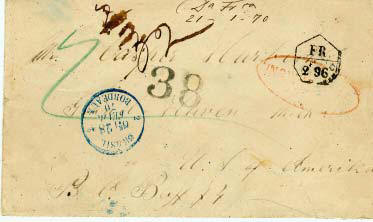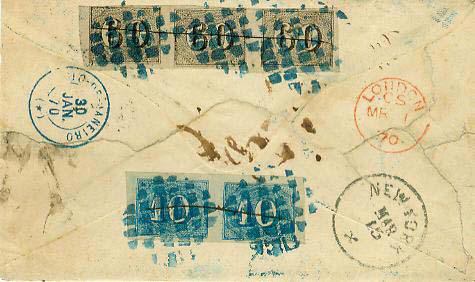The History of a Letter
By Dr. Klerman Wanderly Lopes
Introduction
The so-called War of Secession of the United States, between 1861
and 1865, pitted 11 Confederate States of the South, whose largely
agricultural production was based on the work of slaves originating
from Africa, against the States of the North, which was already
quite industrialized. The war, which cost the lives of close to
970,000 people (about 3% of the U.S. population at the time)
involved an enormous consumption of metals for the manufacture of
weapons. Besides the war itself, the high cost of metals also
affected the postal services, leading the authorities to encourage
the payment of postage with coins, charging a higher rate for fees
paid with paper money. This dual fee regime persisted for many years
after the end of the conflict. To illustrate this postal curiosity,
we present an interesting letter in which this differentiated fee
was applied.
Presentation of the philatelic piece

Front

Back
Description
Letter from Rio de Janeiro to the United States, of January 30,
1870, transported by the ship Amazone, of the French “Messageries
Impériales”. It was franked with 200 réis in Brazilian stamps, an
amount insufficient for the payment of the simple fee in force at
the time of 540 réis to the United States (weight up to 7.5 grams)
for the English or French mail. Thus, the postage was considered
insufficient and the oval postmark indicating that fact was applied
to the front, subjecting the letter to full payment of the freight
charge at the destination. The Amazone landed in Bordeaux on
February 27 and the letter was received in Paris the next day. There
the letter was considered double rate or franking (weight between
7.5 and 15 grams), receiving a written notation “2”, the postmark of
entry “Brésil/2 Bordeaux 2” and the French-British exchange mark
“FR/2F 96c”. Sent to America by the English Postal Service, it
transited in London on March 1. Upon arriving in New York on March
15, the letter received the postmark with the rate of 38 cents (in
paper money) and the written notation “32,” the amount to be
reimbursed to the British and French postal services.
Additional Comment
When the letter arrived in France, the U.S.-France Convention
was no longer in force (since December 31, 1869), and the
French-British Convention was used to obtain the reimbursement for
the transport of the letter to France, seen by the mark of the
second freight charge and the exchange mark applied in Paris. The
letter was sent to New York under the conditions of the U.S.-England
Convention of January 1870. According to its terms the American
Postal Service should have paid the British Postal Service (for each
1/2 ounce of weight) 2 cents for the British transit and 2 cents for
the Trans-Atlantic transportation, in addition to the 28 cents for
the fare owed to France (double freight charge = 1 Fr 48 c).
Therefore, the total to be reimbursed to the English Postal service
was 32 cents (written on the front). In accordance with the
Convention of 1870, the American Postal Service should have
collected 2 cents for the internal distribution, making up a total
of 34 cents en payment in metal money or 38 cents in paper money.
Thanks to friend Jeffrey C. Bohn for
the comments on the American postal marks.
Copyright © 2011 Klerman Wanderly Lopes

